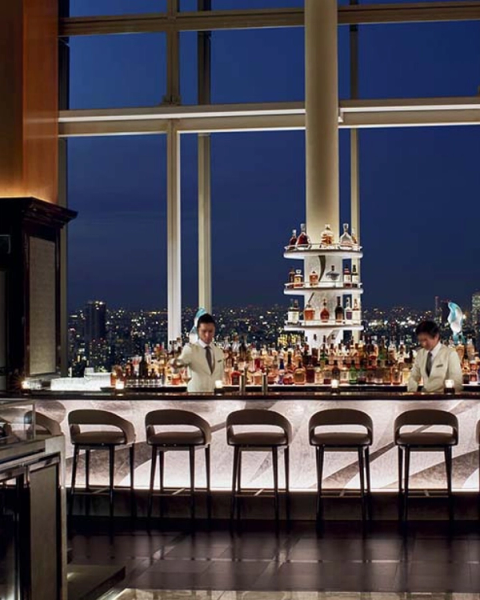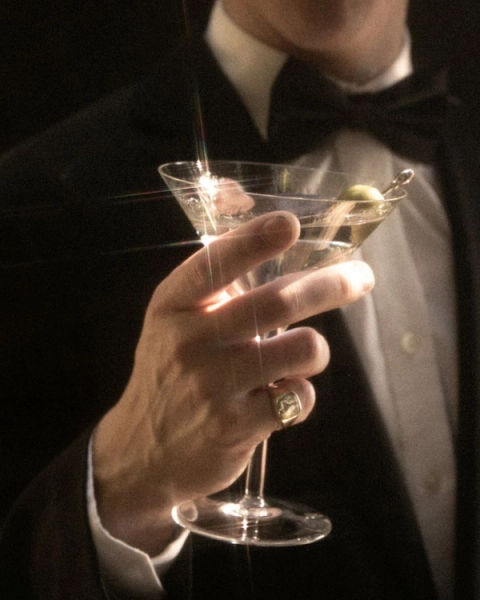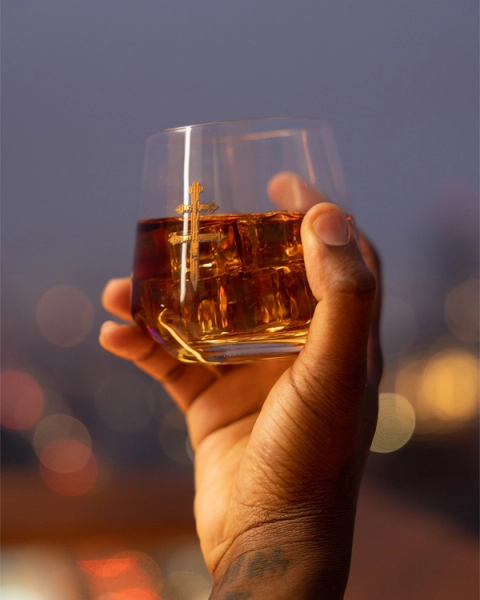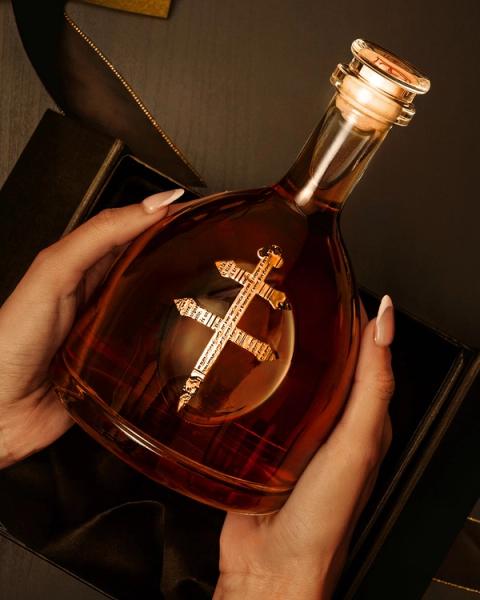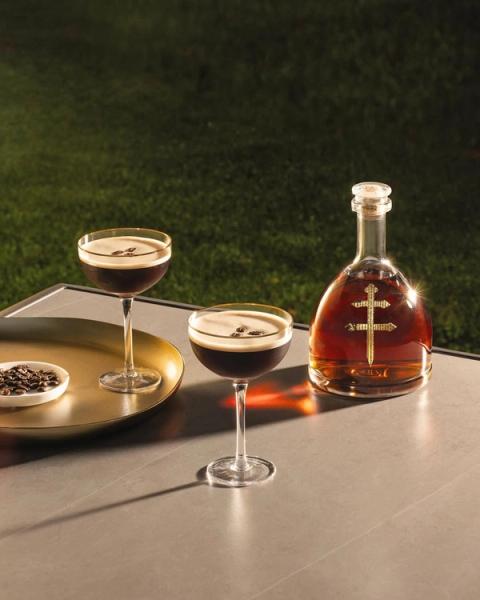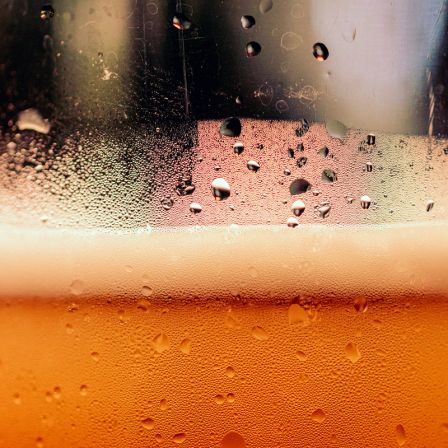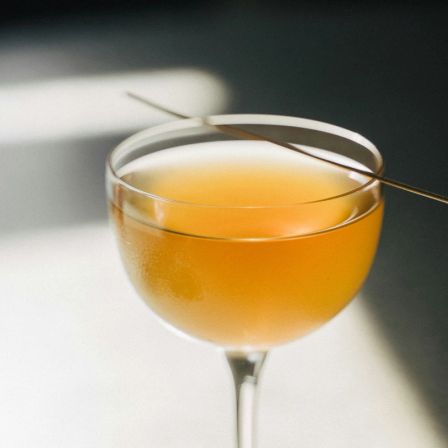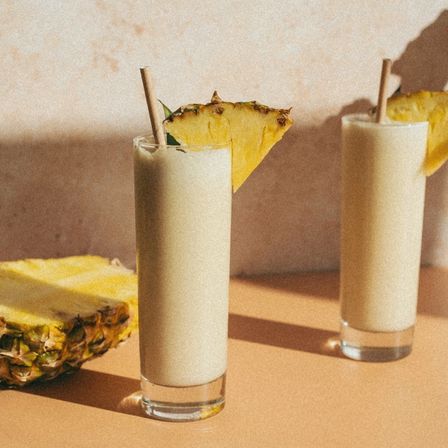- Lifestyle
How to make the world’s most outrageously expensive cocktails
Our guide to the other type of ‘guilty pleasure’ drink. Hospitality professionals look away now — these drinks will lose you money.
- Words By Christopher Madigan

If you google "guilty pleasures cocktails", you generally find lists of sweet and creamy beach drinks such as piña coladas. But those are not guilty pleasures. They are cocktails with a time and a place. A true Guilty Pleasure is when you mix a cocktail with expensive ingredients that you really shouldn't be using — and it tastes delicious.
Whisky makers especially love to tell you how they reject the old rules about drinking the stuff. "What's the best way to enjoy our whisky? Your way!" Sure, when you're talking about their 12YO. But tell them you'd like their 25-year-old single malt in a sour and watch them go puce.
What's the best way to enjoy our whisky? Your way!
However, if a margarita is improved by using fresh lime juice instead of marg mix, or a well-chosen vermouth will enhance your manhattan, it stands to reason that upgrading the lead spirit will elevate the cocktail even higher. Apart from a few exceptions, you rarely encounter these extremely elevated cocktails on bar menus, because hospitality operates on the principle of gross profit — each drink has to justify buying the ingredients for it, by selling and being priced with a decent margin. The hike in pricing required when the ingredients are expensive tends to reduce sales, so it’s not done.
So, when a cocktail bar does serve a guilty pleasure cocktail, they go way over the top for the publicity. Tokyo’s Ritz-Carlton's Diamonds Are Forever Martini at over ¥2.5m (£13,000) is not even really a martini. They cut down on the cost by replacing vermouth with lime juice. It is vodka-based and they do use the premium Absolut Elyx, but that costs about £7 more than regular Absolut. No, the price is covered by the garnish, which is, you guessed it, a one-carat diamond.
The first holder of the Guinness World Record for most expensive cocktail was priced purely for liquid. It was the Ritz Sidecar, served in the 1990s at the Paris hotel’s Hemingway Bar by the legendary Colin Field, now retired. The cognac-based classic (1.5 parts cognac; 1 part triple sec; 0.5 parts lemon juice; shake) had a €1,500 price tag thanks to the 1865-vintage cognac at its heart.
The first holder of the Guinness World Record for most expensive cocktail was priced purely for liquid.
At home, however, you don’t need to prise the jewels from granny’s earrings for a garnish. A bit of an upgrade in base alcohol (and, in some cases, the modifiers) and you can enjoy a hyper-luxe “if this is wrong; I don’t wanna drink right” guilty pleasure cocktail...
Step One: What Would Jay-Z Do?
Shawn Carter, Jay-Z, Jigga, HOVA, El Presidente... call him what you like, but don’t call last orders. The man knows the drinks business and owns two brands that will raise the price of your cocktails.
His cognac label, D’Ussé, was blended by Château de Cognac’s cellar master Michel Casavecchia until his recent retirement. That’s the 200-year-old home to the highly regarded Baron Otard cognac. This is very good liquid.
One recommended serve is the Billionaire's Sidecar, which uses D’Ussé XO instead of VSOP — i.e. minimum 10YO eaux de vie in the blend instead of 4YO. There is another replacement, the triple sec, but I’ll come back to that below.
Even the “basic” gold bottle of non-vintage brut costs almost £300, and a magnum of the latest release, 2015 vintage blanc de noirs, is around 10 times that.
The other brand he owns is Armand de Brignac Champagne (aka Ace of Spades) - and again, he teamed up with a maison with history and pedigree, this time Cattier. Even the “basic” gold bottle of non-vintage brut costs almost £300, and a magnum of the latest release, 2015 vintage blanc de noirs, is around 10 times that.
So, how about a Champagne Cocktail Jay-Z-Style? The old reliable: sugar cube with bitters in a champagne flute with 1 part brandy and 3.5 parts fizz gets a lot blingier with D’Ussé XO and Armand de Brignac.
This principle – choose the showiest, longest aged cognac – applies to other aged spirits. Where a cocktail recipe asks for a dark rum, don’t simply go for the cheap stuff that has caramel in it, go for the rich complexity of an aged rum (extra añejo, if it’s Cuban), such as Ron Zacapa Centenario or Appleton Estate 21YO. The latter is great in a Mai Tai (2 parts rum; 0.5 parts each of lime juice, orange curaçao, orgeat syrup) — and never mind the brand says use the 8YO!
Of course, whisky is where you can really rinse some money in the mixing glass.
Step 2: Do the Smoky Cokey
No, this is not encouragement to break the law and become a tragic figure from The Wire. We’re talking about peated whisky and Coca-Cola. If you find smoky whiskies disgusting, I’m afraid this is not the drink to convert you, but if you are in the camp where “I’m getting iodine, TCP and grilled sardines... with just a hint of burning tyre” are positive tasting notes, then this is the cocktail for you.
The Smoky Cokey (50ml whisky to a third of a can of Coke; a dash of bitters, a squeeze of lemon; stir to make a bit less fizzy) originated when whisky expert and author Dave Broom researched what were the best mixers for different styles of single malt (already tiptoeing into Guilty Pleasure territory). Unsurprisingly to anyone who’s ever tasted quite a sweet Islay whisky, the contrast between the sugary, rich flavours of cola provide a lovely contrast to the phenolic compounds. A brand ambassador for Diageo who was known for his mischievous streak then served up what he was then calling a Smoky Cokey at the Feis Ile, Islay’s whisky festival, using 16YO Lagavulin, and word spread fast.
Now, Laga 16, at about £80 a bottle, is certainly an upgrade on Jack’n’Coke. But we can do better. The extra years of maturation in Laphroaig’s 30YO (£775 a bottle, or £1.10 a millilitre) reveal “more delicate background notes ... such as bergamot, sweet pastries and fresh thyme along with white pepper on the palate” — why not swamp that with Atlanta’s finest caffeinated soda?
Or be subversive and choose a peated Japanese whisky (with the extra guilt coming from the fact that peated malted barley is shipped to Japan and the whisky then travels back). Like a £600 Chichibu if you’re a cheapskate. Or perhaps the 2024 Hakushu 18YO peated malt from Suntory’s annual Tsikuriwake Selection, at £1,250, if you have the samurai spirit.
And if you really want to make this cocktail iconoclastic, you could test just how approving Diageo is of this cocktail by becoming a private client of theirs and acquiring one of the very limited (just 274) sets of Port Ellen Gemini — a pair of 44YO single malts from the former ghost distillery that was revived in 2024.
Step 3: Reach for the Top Shelf
Remember that Fever-Tree ad: “If three quarters of your gin and tonic is the mixer, shouldn't you mix with the best?” While Fever-Tree is a good tonic, the response of many people was, “If three quarters of your gin & tonic is the mixer, you’re mixing it pretty bloody weak.” A spirit and mixer shouldn’t be dominated by the flavour of the mixer, and in most cocktails, the lead spirit’s quality should lead the way in flavour.
If three quarters of your gin and tonic is the mixer, shouldn't you mix with the best?
Easy enough to be transgressive with aged spirits. What about clear ones?
First, tequila. Every expert will tell you that a “proper” margarita should use silver/blanca/plata tequila. But using a reposado gives it a rounder flavour; using an añejo turns the amp up and, with an extra añejo, it’s Nigel Tufnel scenes: it goes up to 11. But that’s using aging. Clase Azul and Volcan de mi Tierra can be relied upon to bump up the price of a marg – the latter with a style called Blanco Tahona made using traditional techniques; the former with its annual Day of the Dead release with the liquid in a funky lamp base. Another route is to find a mezcal with limited supply because it uses a rare varietal of wild agave that has to be dragged off a mountain by a donkey. Mezcal Reina is a good bet for that.
Even premium vodka is only marginally more expensive than regular vodka (unless you buy the Beluga Epicure Lalique – i.e. you’re paying for the decanter), because the higher quality is only subtly apparent. Why not choose a great Polish vodka, Belvedere 10, where the nuanced flavours of single-estate rye are allowed to mellow and rest for 10 months before bottling... then pour a load of sweetened coffee into it for an espresso martini.
Gin too is a difficult one to be naughty with, but there are super-premium gins: Silent Pool’s Black Juniper (found on a few trees at a certain altitude in Bhutan); Seventy-One (Queen of the Night cactus flowers, which bloom at night and wilt by dawn); Anty gin (yep, made with ants). The best way to appreciate their qualities is in a martini... so I recommend putting the Silent Pool Black Juniper in an aviation (it also includes Nepalese cherry blossom leaves that will be highlighted by the maraschino), the Seventy One in a negroni (it’s wood-aged for two months, so it’s approaching a boulevardier), and the spice and umami of the ants in a red snapper.
Step 4: If you’re going to liqueur, liqueur good
When a recipe calls for triple sec or orange curaçao, opt instead for Grand Marnier. Unlike the other liqueurs, it contains a certain amount of cognac. But don’t just use the Cordon Rouge. As you rise up the expressions – Louis-Alexandre, Centenaire, Révélation — the amount of cognac in the blend increases, until you reach the Grande Cuvée Quintessence, in which even the orange essence is created by steeping Bigaradia orange peel in cognac. Quintessence is blended with eaux de vie that have been preserved in a dame jeanne since 1947. Stick that in your Martinez with gin and two types of vermouth.
A few drops in a daiquiri give it an aromatic, herbal twist.
The other trick is to buy some Chartreuse Élixir Végétal — the medicinal and more expensive concentrated version of the green liqueur. Sprinkle a few drops in any cocktail that asks for Chartreuse or experiment with it when not called for... A few drops in a daiquiri give it an aromatic, herbal twist.

Shop Liqueurs
Our liqueur collection offers a journey through indulgent flavors, from timeless classics to modern innovations. Ideal for cocktails, desserts, or a luxurious after-dinner treat.
Step 5: Go back in time
Vintage liqueurs, vermouths and “bitters” (Campari) are all the rage among bartenders and can be bought at auction. These are unopened bottles from the 1970s and 80s and it’s not just a novelty — they do age a little in the bottle. Plus, recipes evolve — any pre-2006 Campari is coloured with cochineal from beetles (so don’t serve a pre-2006 Campari negroni to your vegan friend).
Campari and vermouth are often good value (even a 1950s bottle of original recipe Lillet will only go for £200-£300), but one cocktail ingredient fetches prices to rival old Macallans: Chartreuse. And particularly Chartreuse from the Tarragona distillery in Spain used by the monks for much of the 20th century. Pre-war bottles can fetch thousands, and make a conclusive statement in a Last Word (30ml gin, 20ml green Chartreuse, 20ml maraschino, 20ml lime juice).
Step 6: Go Absolutely Mad...
Our version of a Palo Negro (usually a mix of reposado tequila, palo cortado sherry, dark rum, Grand Marnier and brown sugar syrup) should set you back a bit. One caveat: we haven’t actually attempted the recipe, so you may have to try it a few times to adjust the amounts for perfect balance and increased guilt.
- 45ml Clase Azul Ultra Extra Añejo tequila (£2,600 a bottle)
- 22.5ml Barbadillo Versos Amontillado (if you can find someone reselling one of the 100 bottles of 19th-century fortified wine, which originally sold for £8,000 in 2018; failing that, Barbadillo Reliquia Palo Cortado, at a mere £370... for a half bottle)
- 10ml Brugal Limited Edition Andres Brugal rum (north of £2,000 a bottle)
- 5ml Grand Marnier Grande Cuvée Quintessence (as mentioned, at least £1,500)
- 2.5ml Sugar syrup made by melting a case of Nobline Switzerland Gold Sugar cubes ($360 for nine basic sugar cubes, which have been gold-plated - which will of course disappear when you melt them into a 2:1 syrup, rendering them utterly pointless. The ultimate guilty pleasure).
Come on in the Chablis lovely, Your new home of drinks.
Stay up to date with all the latest from House Of Decant.

